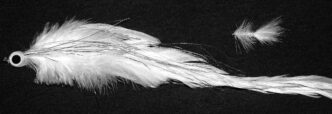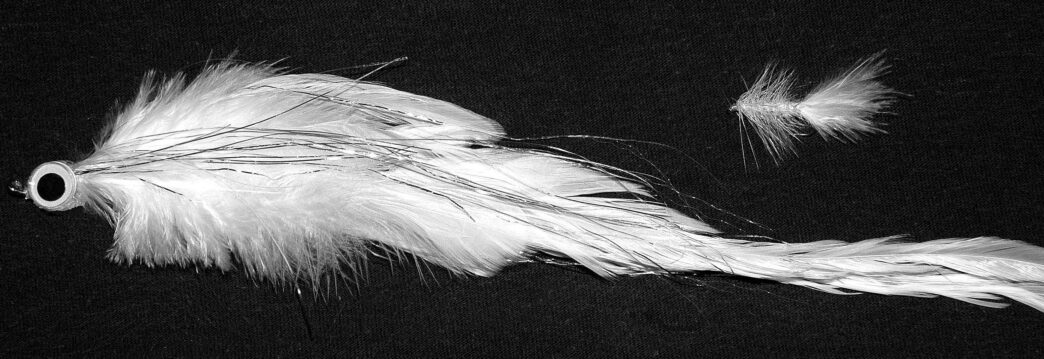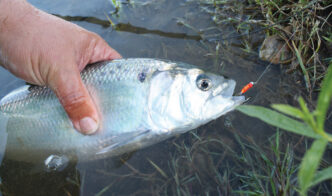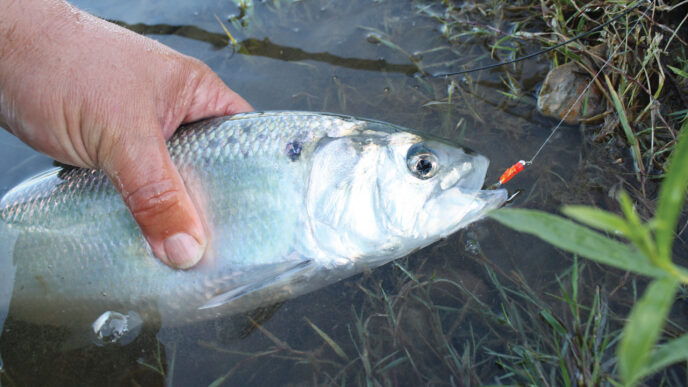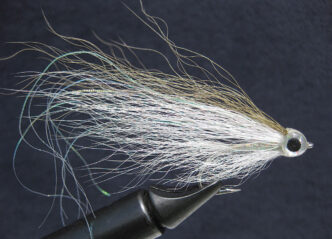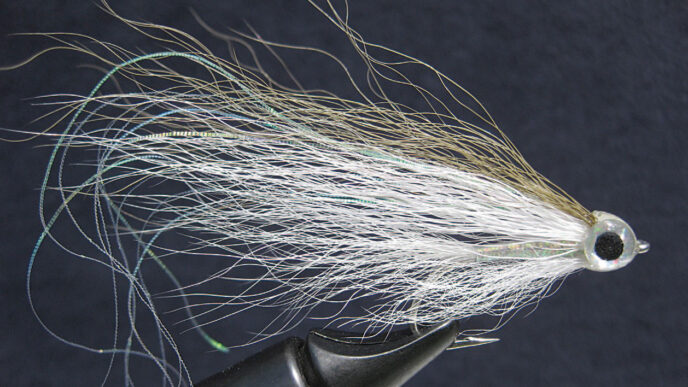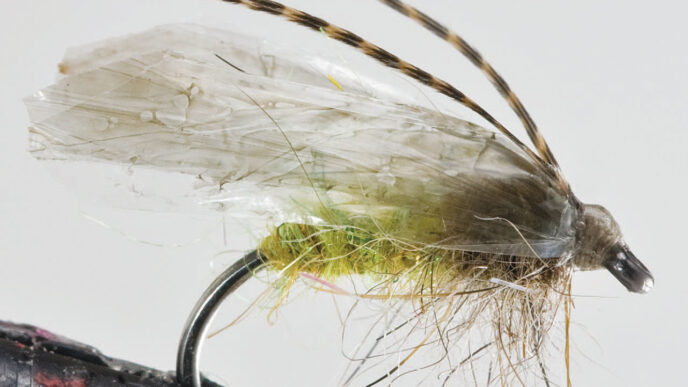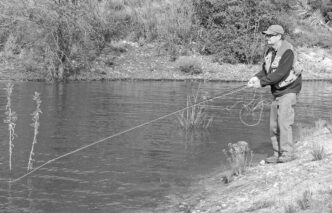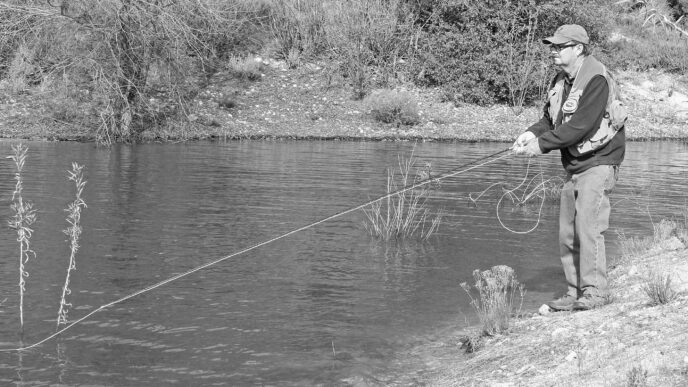Every winter and spring, the small lake I manage receives several truckloads of chum in the form of hatchery rainbow trout. While a lot of these fish exit the lake on kids’ stringers, a number are consumed by largemouth bass. Large female bass emerging from the cold of winter are preparing to spawn. Egg production requires a lot of energy, so the big ladies vacuum up the hapless trout with gusto. Conventional tackle bass anglers are well aware of this chumming phenomenon and “match the hatch” with a variety of large lures. Each year, I watch these guys haul out bass weighing from 5 to 10 pounds.
Fly fishers can get in on this game, as well, but to do so, they need to be able to heft some pretty gnarly flies. This is one situation where a size 8 Woolly Bugger simply isn’t going to cut it. The fly needs to be at least six inches long to get the attention of the hefty gals. That’s a lot of feathers. The successful fly fishers are the ones chucking chickens.
Fishing for trout-eating bass isn’t the only large-fly situation in California, either. Striped bass in the Delta, reservoirs, and the Pacific surf are suckers for large flies. Large rockfish and lingcod are also partial to a big mouthful. And as many dedicated trout anglers will tell you, some of the largest brown trout are caught on mouse patterns. If you can handle a large fly, you can tap into some really exciting fishing.
Clearly, the term “large fly” is relative. The guy who fishes spring creeks has a very different perspective from the average striper or largemouth bass angler, and even the bass angler’s flies are small when compared with the monsters wielded by bill-fishers. However, few of us spend a lot of time fishing for billfish, so let’s call “large” any fly that is mounted on a 1/0 or larger hook or is over five inches long.
As anyone who has attended the winter fly-fishing shows knows, there are experts who make casting big flies look easy. For a number of years, Mark Sedotti, a skilled fly fisher from the Northeast, would perform jaw-dropping demonstrations. With a single-handed rod and a backward cast, he would heave foot-long flies well over 100 feet. Inspired by the experts, many folks go home, dig out some tackle, and spend half an hour trying to throw even a dinky five-inch streamer half as far. Most give up in total frustration. It does not have to end this way.
Mere mortals really can throw large flies for distance with accuracy — maybe not as far as Mr. Sedotti’s Herculean hefts, but certainly far enough to catch fish. To succeed at this game, all you need to do is pay attention to your tackle and your cast. Once you have those elements sorted out, hurling large flies is really no more difficult than casting small flies to trout.
Fly Design
To be successful when casting large flies, it really helps to understand the purpose and constraints of fly shape and construction. While it is important that the fly matches the prey, visually and acoustically, it is absolutely vital that it can be cast far enough and with reasonable precision. There’s no point having the perfect fly if you can’t get it to the fish.
First and foremost, consider the air resistance of the pattern. Perhaps the most problematic flies in this regard are foam bodied poppers. These flies are designed to create quite a disturbance when pulled through the water. However, when it comes to casting these flies, the blunt face and wide body can be a real drag — literally. Getting them out any distance is going to require effort, technique, and with anything mounted on a 2/0 or larger hook, a heavyweight line and matching stick.
By all means, fish these patterns if the extra effort is worth it, but don’t be a slave to them. You can achieve much the same level of surface disturbance and subsurface noise by fishing a more aerodynamic div-er-style pattern. Deer hair divers in sizes similar to the drag-inducing poppers can usually be cast on a 7-weight or 8-weight rod. And don’t worry too much about losing anything in terms of disturbance or noise when switching from a popper to a diver. A few years back, Lee Haskin and I used a hydrophone (a microphone that works underwater) to test the subsurface noise generated by a variety of top-water flies. To our surprise, some of the loudest patterns were divers.
For subsurface patterns, you can reduce air resistance by using flies that are tied with materials that collapse when wet. For example, saddle hackles, craft fur, and rabbit strips become pencil thin when wet and pulled out of the water. This makes casting a lot easier. Once submerged, these materials quickly expand, creating a large target for hungry fish. I am particularly fond of Deceiver-style flies tied with long schlappen hackles for imitating planter trout, shad, sardines, and smelt. Synthetic materials, such as Flashabou, can also be used in baitfish patterns to create an illusion of size without adding bulk. And tube flies are a great way to add volume and length while using smaller, lighter hooks.
The density of large flies (the ratio of weight to volume) is far more critical than it is for smaller imitations, such as nymphs or dries tied for trout. Once you scale up to large flies, the changes in volume or weight can be significant. And unlike when casting trout flies, when casting big flies, the fly line is often operating close to its limits. Simply put, your flies need to be in the Goldilocks zone — neither too light nor too heavy. If the fly is too light, relative to its volume, it won’t have enough momentum to turn over properly at the end of the cast. Conversely, if the fly is too dense, it will tend to kick around on the cast and fly like a psychotic parakeet. Getting impaled midcast by a large, whiplashing fly is no laughing matter.
The obvious way to tell if a fly has the right weight-to-volume ratio is actually to cast it, but let’s get real — that isn’t always an option. Fortunately, there is a relatively easy way to figure out if a fly is going to behave. Simply throw the fly by hand. A well balanced fly will move cleanly through the air in a graceful arc, sort of like a badminton shuttlecock. If it tends to waffle or stall out or if it flies fast and lands like a lead weight, it is probably going to cause troubles on the water. For those of you who purchase flies online, it is therefore probably best to buy well-established patterns from reputable companies or well-known tyers.
Another factor to consider is the shape of the fly. Whenever possible, you want something that is symmetrical and has a clean profile. If the fly isn’t in line with the hook or if it sports a large projection such as a lip, it will tend to helicopter or move erratically during the cast. You can overcome this to a certain degree by using a really heavy leader, but distance and accuracy will still suffer. Occasionally, a fly starts out casting well, but eventually develops flight problems. This usually means something got knocked out of place. A common problem is tail wrap, when fur, hair, or feathers wrap around the hook bend. Long flies with soft, seductive tails are particularly prone to tail wrap. This can cause erratic flight and, worse yet, improper action in the water. Even if the fly appears to be casting correctly, it pays to inspect it regularly to ensure everything is in the right place.
Leaders
Forget about the long, supple, multiple-X-rated leaders you use for trout fishing. To transfer energy from the line to a large fly properly, you need something short and stout. Quite frankly, for largemouth bass, striped bass, large trout, and even big steelhead, you seldom need to use less than 15-pound test. Many bass anglers use 30-pound or 40-pound test with good results. You can always use fluorocarbon if you are neurotic about visibility.
However, thicker mono leaders tend to be stiff, which can create problems with turnover and accuracy. One solution embraced by the steelhead fraternity (many of whom have the equivalent of doctorates in fishing tackle) is to use leaders that feature a monofilament core and a tapered plastic coating — Polyleaders or VersiLeaders. Another option is to use twisted or furled leader butts. A really superb setup that I often use is available to anyone with a clear intermediate line. Cut off four or five feet from the back end of the line and turn it into a leader butt by putting a braided mono loop on one end and connecting a short length of tippet to the other end. Because the leader is made from actual fly line, the casting loop is transferred down to the fly much more cleanly than with other materials, and this results in improved accuracy.
Big-fly leaders seldom need to be longer than 7 feet and can often be much shorter. I know this may sound foolish to folks used to fishing for selective trout on technical waters, but I promise you that it has been proven time and again by anglers who know their stuff. Shorter leaders significantly improve casting control and delivery. When fishing bass bugs, a 4-foot leader is plenty. The fish are usually focused on the bug and are almost oblivious to anything else. Six feet is the most you will need for stripers, even in clear water. Subsurface patterns, especially those fished on clear intermediate lines, seldom need more than 5 feet of leader. My friend David landed several very large trout when fishing smelt patterns on a 4-foot leader. The biggest was easily over eight pounds. Make no mistake, short leaders are a critical component in the big-fly delivery system. Embrace them.
Fly Lines
Anyone who has stepped into a well stocked fly shop or looked online can’t fail to notice just how many lines are on the market these days. Before you buy a new fly line, you need to understand that big flies and fly lines are like trucks and trailers. To get the most efficient setup, you need to match these two components.
Trying to cast a large fly on a light line is like trying to tow a fifth wheel with a motorbike. The line simply does not generate enough power to pull the fly through the air. In addition, the long front taper on many conventional fly lines is designed to deliver relatively small flies. The air resistance and mass of a large fly is too much for the taper to handle. Nine times out of 10, the cast simply won’t unfold. You could always use a 12-weight rod and matching line to deliver pretty much any fly, but for anything less than tarpon or sailfish, such gear is serious overkill. It is also very tiring to cast for hours on end.
Thankfully, fly-line engineers have come to the rescue. Many manufacturers sell lines that are designed specifically for large flies. These lines typically feature short front tapers and belly sections that have a forward weight bias. Perhaps the best way to ensure that you get the right line is to contact one of the manufacturers and tell them what flies you want to use and how far you need to throw them. If you don’t have the time for that, a simple rule of thumb is that flies tied on hooks up to 1/0 can be handled with 8-weight lines. A 9-weight line will usually handle flies tied on 2/0 hooks and in a pinch can handle a 3/0. With anything beyond 3/0 hooks, you should be thinking about a 10-weight. This is a conservative line-to-fly sizing rule that should get you in business under most circumstances.
For those folks who tie their own flies, you may be able to step up a hook size or two with flies that are lighter and more aerodynamic. For instance, I sometimes fish 3/0 Crease Flies on an 8-weight. That said, I have no hesitation in hauling out a 10-weight when I need to cover all the bases.
Rods and Casting
A number of people advocate medium or even slow-action rods for casting bulky flies. Various arguments have been used to support this recommendation. I believe the main reason why slower rods make casting big flies easier is because they help compensate for faulty cast timing. Large flies tend to slow down the tempo of the cast. Many folks cast at the same speed and tempo, regardless of what is on the end of their tippet. If you don’t adjust to the fly, you will start the forward cast prematurely, which is a surefire way to mess things up. Fast rods and large flies are less forgiving of poor timing. If you occasionally check your back casts and properly match the tempo of the cast to the line and fly, you will find that most rods, regardless of action, will work just fine. In fact, in the right hands, a fast-action rod produces tighter line loops and will actually cast wind-resistant flies farther than a medium-action or slow rod.
But let’s be honest. Getting the combination of a fast rod and a large fly to work well all the time requires more concentration than most fly fishers can muster. Even the most competent casters get tired or distracted, and their timing inevitably slips a little. As such, probably the best solution is to use a medium-fast rod. This is good news. There are loads of medium-fast rods on the market, and you can get a perfectly good one for $200 or less. You don’t need second mortgage to get into this game.
Large flies are difficult to cast far with great accuracy. This means you should follow the photographer’s rule of getting as close to your subject as possible. For largemouth bass, 30 to 40 feet is usually plenty of room. At that distance, the line will load the rod nicely, and accuracy should be good enough to plop the fly down into the weedy, twiggy spots where bass often hang out. Fish feeding in more open waters sometimes shy away from water that is constantly slapped with casts. Even so, 50 or 60 feet usually provides plenty of buffer, and with the right combination of rod, line, and fly, such casts are well within the reach of most fly fishers.
Perhaps the ultimate challenge comes when you fish large top-water flies for stripers in the surf. Waves, currents, and topography limit just how far you can wade out. If the fish are feeding 100-plus feet offshore, you are probably going to have to throw that large fly 70 or 80 feet. Sometimes, even that isn’t far enough, and casts of 90-plus feet are needed. Clearly, this is pushing things to the extreme. But you only have to watch a large striper crash down on a top-water fly as it splashes through the surf to understand the allure. The intense adrenaline spikes and surges of dopamine-induced euphoria make this fishing obscenely addictive.
Of the handful of folks I know who have become obsessed with this game, many have switched to two-hand rods and Skagit heads. The long rod and Skagit head (cast overhead style) is perhaps the easiest way to throw giant flies in the suds. I confess that I have been down that road, too, but I keep coming back to singlehanded rods. There is something about the feel of the single-handed rod that makes it so much more appealing to me. With a fast 10-weight and large, well-balanced flies, I can easily stay with the Skagit guys. Of course, you can’t always spend your time in the surf, fishing with huge flies for massive fish. Sometimes it’s nice to scale things back and relax in a small boat or float tube while throwing 10-inch-long rainbow trout patterns at big largemouth bass. Fly fishing is about delicacy, after all.



